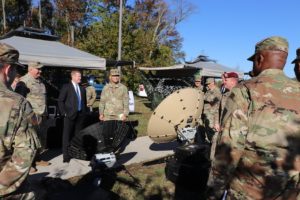The Army has completed its critical design review for its first tactical network modernization capability drop (CAPSET 21), officials said Tuesday, and is preparing to solicit industry offerings to compete for initial Integrated Tactical Network components.
Maj. Gen. Pete Gallagher, director of the Network Cross Functional Team (CFT), also noted the Army has 17 prototype deals in place to test technologies that may be included in CAPSET 23 or CAPSET 25.

“We’re moving faster to keep pace with emerging technology while we’re addressing those emerging threats that are brewing out there between peer adversaries, both in the cyber spectrum and the electronic warfare arena,” Gallagher said during an online industry event hosted by Aberdeen Proving Ground. “We are in the process right now of new equipment fielding and training for Capability Set 21. That really is our top priority, working with our Program Executive Office – Command, Control and. Communications-Tactical (PEO C3T) teammates, getting it out there and in the hands of soldiers.”
The Army’s plan to overhaul its tactical network is built around capability drops every two years beginning with CAPSET 21, to better keep pace with industry’s technology innovations, and will include network transport capabilities, mission command applications and command post computing environments
Joe Welch, deputy PEO C3T, detailed the Army’s plan to release Request For Information notices to industry later this summer to find additional providers for CAPSET 21 capabilities based on prototyping used to inform the critical design review.
“Although we’re buying our first four brigades of [CAP SET 21] capability in FY ‘20, simultaneously going through the rest of FY ’20 and the beginning of FY ‘21, we’re going to be looking at how can we make that available at a better value. When I say better value, I’m talking about going after the same kind of a capability at a lower cost or more capability at the same cost,” Welch said.
The RFIs will look to solicit industry’s commercial-off-the-shelf capabilities for single channel radios, dual channel headsets, variable height antennas, line-of-sight backhaul radios, tactical radio gateways and mobile broadband kits.
Gallagher said the 17 prototype efforts to inform network design choices for CAPSET 23 and 25 are broken up between three deals worked through DoD’s Rapid Innovation Funding, eight that are transitioning out of Army C5ISR Center science & technology programs and six that come from the Army’s technical exchange meeting with industry in Austin, Texas last fall.
The Network CFT is planning to hold its next technical exchange meeting with industry in early September, with additional details to be provided by mid-July.
The event will be held virtually as well as in-person in Nashville, pending conditions of the ongoing pandemic, according to Gallagher.